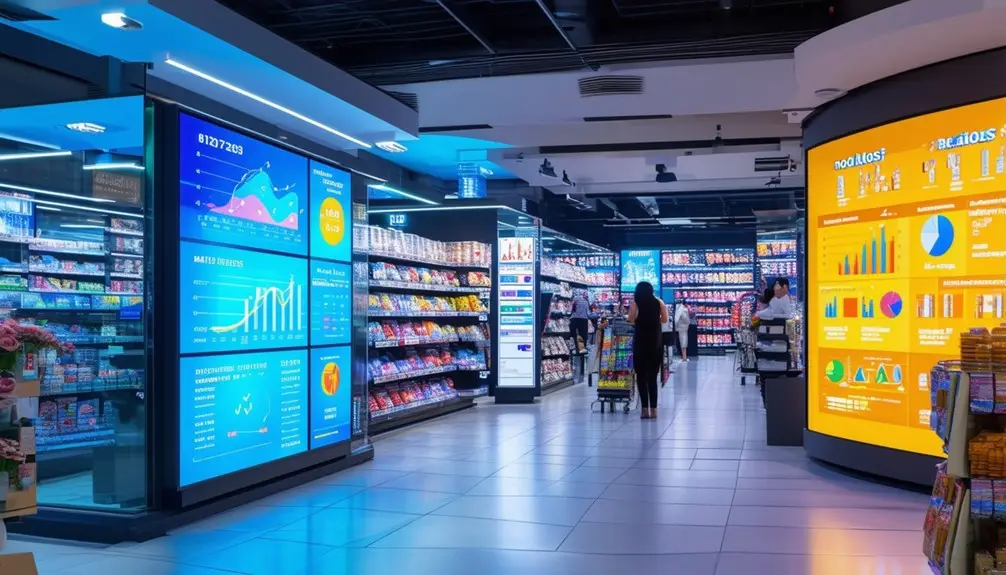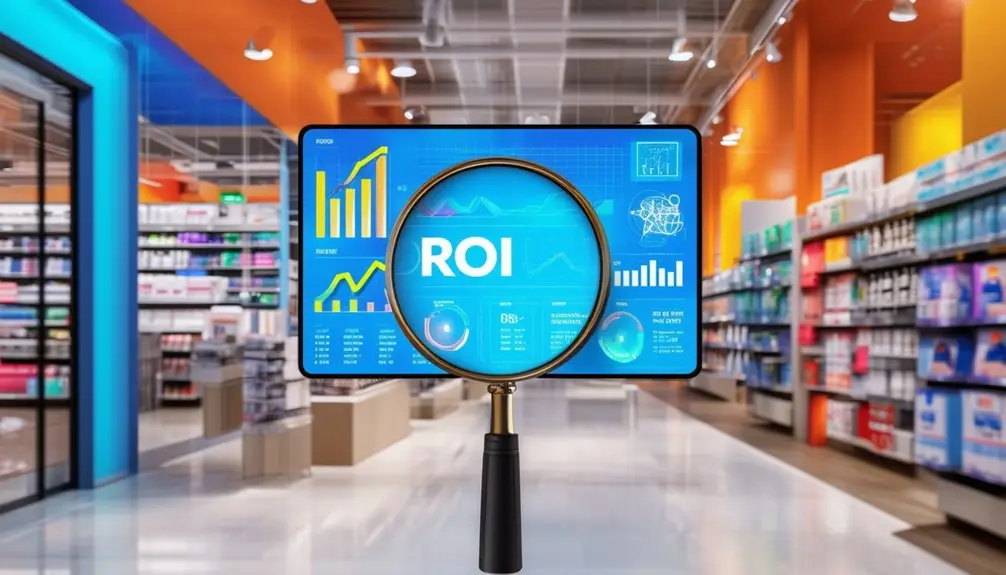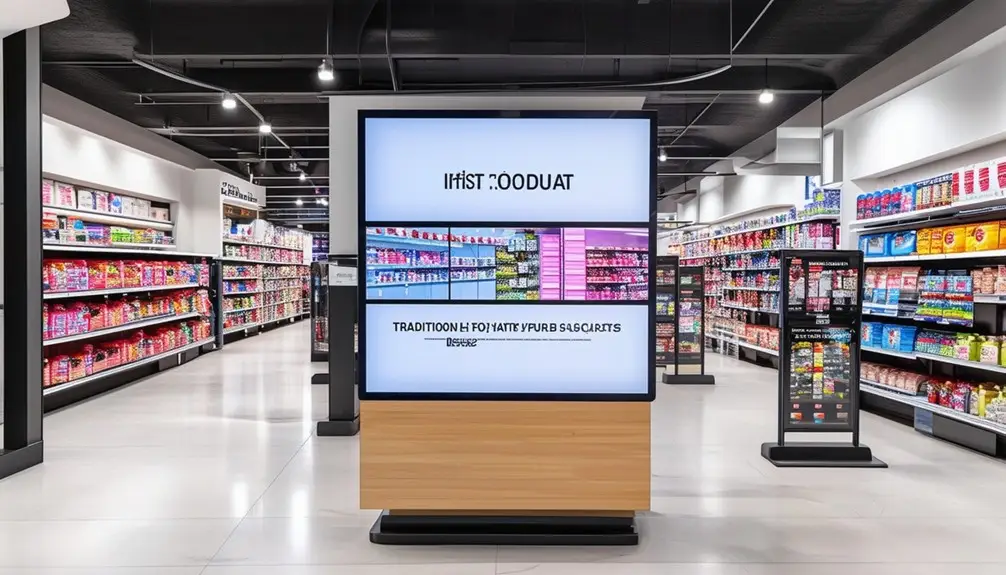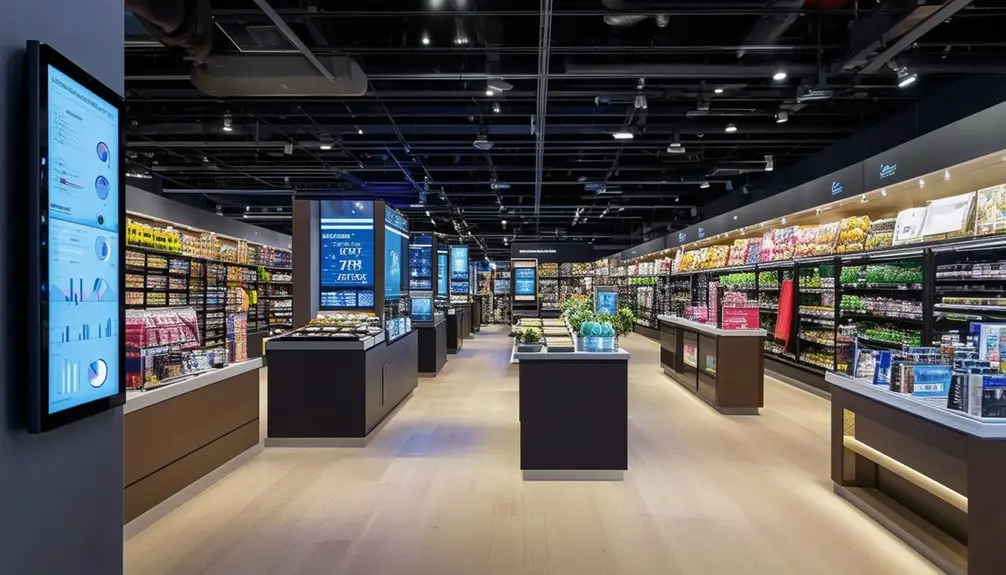Investing in digital signage for your retail store can greatly improve ROI by boosting customer engagement and sales. Use clear objectives to align your digital signage with strategic goals and measure key KPIs like sales lift, conversion rates, and average transaction value. Analyzing sales data, foot traffic, and customer feedback offers strong insights into effectiveness. Digital signage also reduces costs through automated content management and durable displays. Real-time performance monitoring and strategic A/B testing help optimize content for maximum impact. This integrated approach ensures that your investment delivers measurable outcomes, improving overall store performance. For deeper insights and strategic tips, stay tuned.
Key Takeaways
- Measure customer interaction and sales lift using digital signage for data-driven ROI evaluation.
- Optimize content with frequent updates and strategic placement to enhance engagement and conversion rates.
- Employ analytics, such as dwell time and foot traffic, to continuously improve digital signage effectiveness.
- Utilize cost savings from reduced traditional signage, labor, and maintenance expenses to maximize ROI.
- Implement A/B testing to refine content based on performance data, ensuring impactful customer engagement.
Importance of ROI in Retail

Understanding the significance of ROI in retail allows you to measure the effectiveness of your digital signage investments and optimize resources strategically. By evaluating ROI in retail, you can identify which digital signage solutions are driving customer engagement and boosting sales. Measuring customer interaction with your digital displays is pivotal for determining the success of these initiatives.
When you calculate ROI, you compare revenue figures before and after implementing digital signage, account for associated costs, and determine the percentage return on your investment. This precise evaluation helps you make data-driven decisions, ensuring that your budget is allocated to the most effective digital signage solutions.
Understanding ROI in retail aids in enhancing customer engagement. Effective digital signage can capture customer attention, provide relevant information, and create a more interactive shopping experience. By analyzing the ROI, you can fine-tune your content and strategies to better meet customer needs and preferences.
Setting Clear Objectives

Setting clear objectives is crucial for measuring the success of your digital signage initiatives and aligning them with your retail store’s strategic goals. By defining specific, measurable goals, you can guarantee that your digital signage efforts are geared toward tangible outcomes, such as boosting sales, enhancing customer engagement, or improving overall store performance.
When you set clear objectives, you provide benchmarks that allow you to measure retail digital signage ROI effectively. For instance, if your goal is to increase sales, you can track sales data before and after the implementation of digital signage to gauge its impact. Similarly, if you aim to enhance customer engagement, you might look at metrics such as dwell time, interaction rates, or customer feedback.
Clear objectives also guide your strategic decisions, ensuring that every action taken aligns with your desired outcomes. Whether your focus is on driving immediate sales or building long-term customer loyalty, having well-defined objectives helps you assess the impact of digital signage accurately. This, in turn, allows you to allocate resources more effectively and make informed decisions about future investments. Ultimately, setting clear objectives is the cornerstone of measuring and maximizing the effectiveness of your retail digital signage.
Identifying Key KPIs

To measure the impact of your digital signage, focus on key KPIs like sales performance metrics, customer dwell time, and conversion rates. These indicators provide actionable insights into how well your signage drives revenue and engages customers. Additionally, evaluating content effectiveness helps you refine your strategy for maximum ROI.
Sales Performance Metrics
Effective measurement of digital signage ROI hinges on pinpointing key sales performance metrics like sales lift, conversion rates, and average transaction value. These metrics enable you to assess how well your digital signage is driving sales and enhancing your store’s overall performance.
By tracking sales lift, you can determine the incremental sales attributable to digital signage. Monitoring conversion rates helps you understand how effectively your signage turns browsers into buyers. Additionally, analyzing the average transaction value reveals whether customers are spending more per visit due to targeted promotions or compelling content.
Here’s a breakdown of essential metrics:
| Metric | Definition | Impact on ROI |
|---|---|---|
| Sales Lift | Increase in sales attributable to signage | Directly correlates with revenue growth |
| Conversion Rates | Percentage of visitors who make a purchase | Higher conversion rates boost sales |
| Average Transaction Value | Average amount spent per transaction | Increased value indicates better upsell |
| Store Traffic | Number of visitors to the store | More traffic can lead to more sales |
| Repeat Purchases | Frequency of returning customers | Higher retention rates improve ROI |
Strategically analyzing these metrics gives you actionable insights to optimize your digital signage efforts. By focusing on these KPIs, you’ll be well-equipped to enhance your store’s sales performance and achieve a higher return on investment.
Engagement and Dwell Time
Leveraging data on customer engagement and dwell time is essential for evaluating the impact of your digital signage in retail environments. By focusing on these key performance indicators (KPIs), you can gain valuable insights into how effectively your retail digital signage captures and retains customer attention.
To measure customer engagement, track metrics such as the average time customers spend near your digital signage and interaction rates. These data points reveal how engaging your digital content is and how well it drives customer interaction. A higher average dwell time indicates that customers are interested in what they see, which can lead to increased conversion rates and sales.
Analyzing dwell time patterns also helps you understand customer interest levels and tailor your content accordingly. For instance, if you notice that specific content holds attention longer, you can optimize your signage strategy to feature more of that type of content. Additionally, by strategically placing digital signage in high-traffic areas, you can maximize engagement and enhance the overall customer experience.
Content Effectiveness Analysis
Analyzing key KPIs like sales lift, customer immersion time, and conversion rates is essential for evaluating the effectiveness of your digital signage content in retail stores. Start by tracking sales lift to see if your displays are driving purchases. A clear increase in sales when specific content is shown can directly link your signage to revenue growth.
Next, customer immersion time is a strong indicator of engagement. Measure how long customers spend near your digital signage to gauge interest levels. Longer immersion times often correlate with higher engagement and greater potential for conversion.
Conversion rates are another critical metric. Monitor how many viewers of your signage actually make a purchase or take a desired action. A high conversion rate signifies that your content is compelling and effective.
Additionally, explore customer engagement metrics like clicks, views, and interactions. These data points provide valuable insights into how customers are interacting with your content. Tracking loyalty program sign-ups and coupon redemptions can also offer a deeper understanding of your signage’s effectiveness.
Measurement Methodologies
To accurately assess the impact of digital signage in retail stores, you need to employ a combination of sales data analysis, customer surveys, foot traffic analysis, and thorough research methodologies. Start by analyzing sales data to compare revenue before and after implementing digital signage. This quantitative analysis will give you a clear view of its impact on sales performance.
Customer surveys are invaluable for gathering qualitative research. They provide insights into how engaging and effective your digital signage is from a customer’s perspective. Ask questions about the visibility, attractiveness, and usefulness of the content displayed.
Foot traffic analysis is another critical methodology. By measuring customer engagement around digital signage, you can determine how effectively your content is drawing attention and influencing behavior. Use sensors or manual counts to track this data.
Here’s a snapshot to guide your measurement efforts:
| Measurement Method | Key Focus | Data Type |
|---|---|---|
| Sales Data Analysis | Revenue Changes | Quantitative |
| Customer Surveys | Engagement & Feedback | Qualitative |
| Foot Traffic Analysis | Customer Engagement | Quantitative |
| Observational Methods | Behavioral Insights | Qualitative |
Combining these approaches will offer a robust, data-driven strategy to evaluate the effectiveness of your digital signage in retail environments.
Calculating ROI

Calculating ROI for retail digital signage starts by comparing the revenue generated before and after the implementation, while factoring in all associated costs such as hardware, software, content creation, and maintenance. To measure digital signage ROI accurately, you’ll use the formula: (Gain from Investment – Cost of Investment) / Cost of Investment. Gains typically include increased sales, reduced printing costs, and benefits like improved brand perception.
By analyzing the revenue shift post-implementation, you can pinpoint the financial returns directly attributed to digital signage. It’s essential to itemize all expenses using a digital signage ROI calculator to ensure nothing is overlooked. This tool helps estimate financial benefits and long-term operational efficiencies, making your ROI assessment more precise.
Measuring the ROI of digital signage validates the effectiveness of your investment, guiding strategic decisions and optimizations for maximum returns. Differentiating between ROI (financial returns) and ROO (goal achievement) is crucial, as both metrics offer insights into client satisfaction and overall impact. Accurate ROI calculations empower you to make data-driven decisions, ensuring your digital signage investment continuously aligns with your business objectives and maximizes profitability.
Cost Savings Analysis

Shifting focus from revenue gains, let’s examine how digital signage cuts costs in retail environments. Retail digital signage offers significant cost savings by slashing the expenses associated with traditional signage materials. You won’t have to spend on printing, shipping, or replacing static signs, which quickly adds up. Additionally, labor costs are minimized since digital signage allows for automated content management and updates, reducing the need for manual changes by your staff.
Maintenance costs also see a sharp decline. Traditional signage often requires frequent replacements and repairs, but with digital signage, these issues are greatly reduced. The durability and longevity of digital displays translate into fewer maintenance headaches and costs. Furthermore, energy-efficient displays and automation features in digital signage contribute to lower operational costs. These high-efficiency screens consume less power, hence reducing your utility bills.
Understanding the total cost of ownership (TCO) for digital signage is essential. While the initial investment might seem steep, the long-term cost savings make it a financially sound decision. By evaluating the TCO, you can clearly see how retail digital signage delivers a strong ROI through sustained cost efficiencies.
Enhancing Customer Engagement
Leveraging digital signage in retail environments greatly boosts customer engagement, with studies showing a remarkable 64% increase in shopper interactions. This uptick isn’t just about catching eyes; it’s about transforming how customers experience your store. Digital signage enhances customer service effectiveness by 57%, making it a powerful tool for improving overall satisfaction.
When you’re crafting content strategies for your digital signage, consider these data points:
| Metric | Percentage Increase | Impact on Retail Stores |
|---|---|---|
| Shopper Interactions | 64% | Boosts customer engagement |
| Customer Service Effectiveness | 57% | Enhances shopping experience |
| Store Entry After Viewing Signage | 80% | Attracts potential buyers |
| Margin Per Transaction | 3% | Increases profitability |
With 80% of customers entering stores after seeing digital signage, it’s clear that this medium is pivotal in attracting and engaging potential buyers. By strategically placing digital displays and tailoring your content to your audience, you can create a more compelling and interactive shopping experience.
Additionally, 43% of retailers find digital signage essential for in-store personnel training. This not only improves employee performance but also indirectly boosts customer satisfaction. Effective digital signage in retail stores doesn’t just engage customers; it drives sales and enhances profitability.
Leveraging Analytics

Leveraging analytics in your digital signage strategy allows you to track sales performance and measure engagement metrics effectively. By analyzing data like dwell time and conversion rates, you gain insights that can optimize your content for better ROI. This data-driven approach guarantees that your campaigns resonate with customers and drive meaningful results.
Tracking Sales Performance
To effectively track sales performance, start by analyzing sales data both before and after implementing digital signage to identify shifts in revenue and customer behavior. Leverage analytics tools to measure the impact on sales performance, conversion rates, and average transaction value. By concentrating on key metrics like sales lift and dwell time, you can gain deeper insights into the effectiveness of your digital signage campaigns.
Use the following table to guide your analysis:
| Metric | Description |
|---|---|
| Sales Lift | Percentage increase in sales post-implementation |
| Conversion Rate | Ratio of visitors making a purchase |
| Average Transaction Value | Average amount spent per transaction |
| Dwell Time | Average time customers spend in the store |
| Customer Behavior | Changes in purchasing patterns |
Implement A/B testing strategies to compare different content formats and determine which ones drive the best results. This approach helps in optimizing your ROI by identifying the most effective content, promotions, and product placements.
Measuring Engagement Metrics
Analyzing engagement metrics like dwell time, interactions, and click-through rates provides actionable insights into how effectively your digital signage captivates and retains customer interest. By tracking foot traffic around your displays, you can directly measure customer engagement and see how many people are drawn to your content. This data is vital for understanding the magnetic appeal of your digital signage.
Utilizing analytics tools to monitor conversion rates and sales lift offers a clear picture of your signage’s impact on revenue. For instance, pinpointing how many viewers turn into buyers lets you assess the direct ROI of your campaigns. Additionally, insights into sales lift—the increase in sales attributed to your digital signage—help quantify the financial benefits.
Examining customer behavior data, such as repeat visits and engagement patterns, allows you to refine your content for maximum impact. You can identify which messages resonate best and adjust your strategy accordingly. Using real-time data and analytics guarantees, you make informed decisions to enhance your digital signage’s effectiveness continually.
Incorporating these metrics into your strategy not only boosts customer engagement but also drives measurable results, maximizing your digital signage ROI and enhancing overall store performance.
Effective Content Strategies
Effective content strategies for digital signage in retail stores require frequent updates and strategic placement to guarantee maximum customer engagement and best possible ROI. To start, updating your digital signage content regularly ensures it remains relevant and engaging. Leveraging user-generated content and integrating real-time data can greatly enhance the impact of your digital signage, keeping customers interested and fostering a sense of community.
Strategic placement is equally important. Positioning your digital signage where it catches the most foot traffic maximizes visibility and engagement. Tailoring content to your specific target audience can significantly enhance customer engagement. Align your messaging with your brand’s objectives to make sure of consistency and effectiveness.
Interactive elements, like touchscreens and personalized recommendations, can further increase engagement. These features make the shopping experience more enjoyable and can drive sales by catering to individual customer preferences. Dynamic content scheduling allows you to display the right message at the right time, increasing its impact.
Continuous Optimization

To optimize your digital signage ROI, focus on continuous optimization through data-driven content adjustments and real-time performance monitoring. Utilize strategic A/B testing to identify what resonates best with your customers. This approach guarantees your digital signage remains engaging, relevant, and effective in boosting sales.
Data-Driven Content Adjustments
Adapting digital signage content continuously based on real-time data drives higher customer engagement and maximizes ROI for retail stores. By leveraging data analysis and real-time analytics, you can make informed adjustments to your digital signage content, guaranteeing it’s always relevant and impactful. This form of dynamic content optimization allows you to tailor messages to your customers’ preferences and behavior, leading to increased engagement and conversion rates.
Continuous optimization is a strategic approach that keeps your content fresh and aligned with customer expectations. Here’s how data-driven content adjustments can benefit your retail store:
- Enhanced Customer Engagement: Real-time data helps you understand what content resonates with your audience, allowing you to make immediate changes that capture their attention.
- Increased Conversion Rates: By dynamically adjusting your content based on user behavior and feedback, you can drive more sales and improve overall store performance.
- Higher ROI: Effective use of real-time analytics guarantees that your digital signage investments yield maximum returns.
- Relevance and Impact: Continuous content adjustments keep your digital signage campaigns relevant, making them more impactful and ensuring lasting customer interest.
Real-Time Performance Monitoring
Real-time performance tracking empowers retailers to continuously monitor and optimize their digital signage content for maximum engagement and ROI. By leveraging real-time data analytics, you can quickly identify which messages resonate with your audience and make immediate adjustments to boost customer engagement. This continuous optimization guarantees that your digital signage remains relevant, compelling, and effective.
Monitoring performance in real-time gives you invaluable insights into customer behavior and preferences. For instance, if a particular promotion isn’t attracting attention, you can swiftly modify it or replace it with more enticing content. This agility not only keeps your signage fresh but also maximizes its impact, directly contributing to a higher ROI.
Real-time performance tracking allows you to spot emerging trends and capitalize on them promptly. By understanding what works and what doesn’t, you can refine your strategy on-the-fly, ensuring that every piece of digital signage content is optimized for peak performance. This proactive approach helps you make informed decisions, reducing wasted resources and enhancing overall effectiveness.
Strategic A/B Testing
Strategic A/B testing empowers retailers to fine-tune their digital signage content by comparing different versions to pinpoint what drives the highest customer engagement and sales impact. By leveraging this approach, you can analyze the performance of various elements like visuals, messaging, and calls to action. This enables you to make data-driven decisions that continuously enhance your digital signage strategy.
Implementing A/B testing allows for targeted adjustments and refinements based on real-time performance data, leading to better ROI for your store. Here’s how A/B testing can enhance your digital signage:
- Visuals: Test different images or video content to see which captures more attention.
- Messaging: Compare different headlines or taglines to find the most compelling message.
- Calls to Action: Evaluate various prompts to determine which ones drive the most customer interaction.
- Placement: Experiment with the location of your signage within the store to find the best spot for engagement.
Conclusion
You can’t overlook the impact of digital signage on your retail store’s ROI. With 47% of consumers reporting that they recall a digital display they saw in the past 30 days, it’s clear that strategic digital content can drive significant engagement. By setting clear objectives, tracking key KPIs, and continuously optimizing your strategies, you’ll not only enhance customer experience but also see tangible returns on your investment. Leverage analytics to refine your approach and stay ahead of the competition.
Frequently Asked Questions
Does Digital Signage Increase Sales?
Yes, digital signage increases sales. You’ll see up to a 32.8% sales boost, an 80% rise in store entries, a 3% margin increase, and a 75% success rate in sales-driven content initiatives. It’s a strategic investment.
What Is the Revenue of Digital Signage?
To determine the revenue of digital signage, track sales before and after implementation. Analyze increased customer engagement, foot traffic, and brand loyalty. Measure direct sales impact and indirect benefits to assess the overall financial contribution.
What Are the Benefits of Digital Signage in Retail?
You’ll see increased customer engagement by up to 64% and drive 80% more foot traffic. Digital signage also boosts brand recall by 83%, enhances employee training, and creates a positive first impression, improving overall sales and brand visibility.





